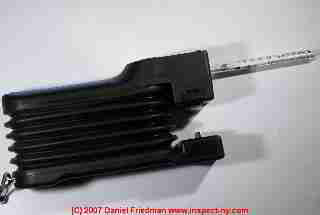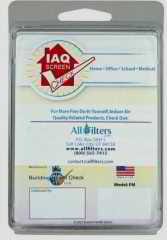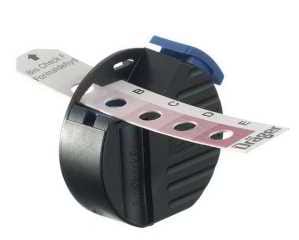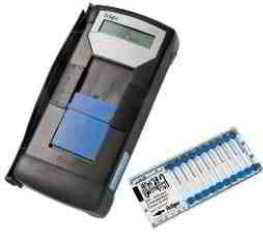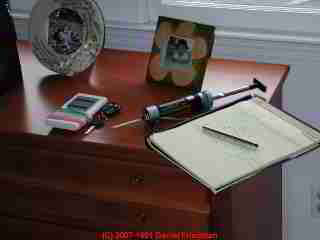 Formaldehyde Gas Test Kits, Instruments, Meters
Formaldehyde Gas Test Kits, Instruments, Meters
Formaldehyde Gas (Formalin Gas) Concentration or Screening Test Devices & Options to detect HCHO
- POST a QUESTION or COMMENT about how to test for indoor gas contaminants
Formaldehyde Gas Detection, Test Methods: formaldehyde test kits, formaldehyde detection instruments, chamber test specifications & formaldehyde test laboratories:
How to measure for formaldehyde outgassing or gas exposure hazards indoors. This article describes different formaldehyde testing methods & lists suppliers of each type of formaldehyde test.
Page to photo, the author's GasTech™ pump using a colorimetric gas detection tube in a private home.
InspectAPedia tolerates no conflicts of interest. We have no relationship with advertisers, products, or services discussed at this website.
- Daniel Friedman, Publisher/Editor/Author - See WHO ARE WE?
Formaldehyde Gas Characteristics, Toxicity, Simple Gas Exposure Measurements
Here is a listing & description of formaldehyde gas detection opotions ranging from simple badges or exposure tests to formaldehyde detection meters, concentration measurement equipment & fomraldehyde emission test chambers. What instruments or test kits can be used to test for toxic formaldehyde gases indoors?
[Click to enlarge any image]
Article Series Contents:
- FORMALDEHYDE GAS TEST KITS, METERS
- FORMALDEHYDE GAS EXPOSURE LIMITS - separate article
- WHEN SHOULD YOU TEST for FORMALDEHYDE - separate article
[Click to enlarge any image]
Watch out: no gas exposure test will accurately describe the actual human exposure levels in a building if the test is not properly conducted. The risks are of both Type 1 Errors (a false positive result) and Type 2 Errors (a false negative result). That is to say that depending on how it was conducted, your test may indicate a costly, actionable problem where in fact there is not one (a false positive) or your formaldehyde (or any other) test may indicate that there is no hazard or no problem when in truth there is one (a false negative result).
InspectAPedia.com is an independent publisher of building, environmental, and forensic inspection, diagnosis, and repair information for the public - we have no business nor financial connection with any manufacturer or service provider discussed at our website.
Tips for Identifying a Formaldehyde Source in a Building
Drager's Bio-Check-F for formaldehyde offers a helpful suggestion for using a formaldehyde gas sensor to track down the probable source of formaldehyde in a building.
Using two test devices (two formaldehyde detection badges, two Bio-Check-F's for example) one detector is placed suspended in air in the room, ideally at head or chest height near the room center.
A second detector is placed on the suspected outgassing surface: a floor, carpet padding, furniture, cabinet.
Both detectors are left in place for the same time period and without changing other room conditions (such as ventilation or occupancy or use).
By comparing the detector readings the user may be able to confirm that the suspected source is indeed the point of origin of formaldehyde if she observes that the source detector has a higher formaldehyde reading than the suspended-in-air detector.
To construct a "worst case" test which in our opinion does not describe occupant exposure levels in a building but might help confirm the source of formaldehyde we might try using a badge type tester under a metal shield over a measured surface area. See the enclosed foil cover described
at SMELL PATCH TEST to FIND ODOR SOURCE
See MOLD / ENVIRONMENTAL EXPERT, HIRE ? for help in deciding if it is probably appropriate to hire an expert to help sort out the question of a building-related illness.
Watch out: beware of self-styled experts who are going to just stop by and perform a test. Without a careful client interview, a taking of the building's history, an observation of its site, construction, materials, history, and other related factors, an environmental test performed alone may give disappointing and expensive results that are not useful: even if a test indicates there is a problem you may have to hire someone over again to perform much the same work in order to find the problem source and to recommend appropriate corrective measures.
The American Industrial Hygiene Association (AIHA) has published "AIHA Formaldehyde Resource Center" (April 2015) which recommends that consumers "... hire an industrial hygienist or trained professional to conduct air sampling." adding that
If you decide to use a home screening test kit to collect a sample, make sure that the samples collected are sent to a qualified, accredited laboratory to test for the presence of formaldehyde. These kits typically contain a small formaldehyde sampler, known as a dosimeter. Be sure to follow all instructions provided with the sampler, and send the device promptly to the laboratory when sampling is complete. - source: AIHA, retrieved 22 April 2015, original source: https://www.aiha.org/publications-and-resources/TheSynergist/Industry%20News/Pages/AIHA-Formaldehyde-Resource-Center.aspx
Really? In fact testing your home for formaldehyde may not be appropriate nor necessary.
See WHEN SHOULD YOU TEST for FORMALDEHYDE
Formaldehyde gas test kits
- Air Oasis Air Quality Test Kit, $35 USD.
- All Filters formaldehyde test kit: badge [illustrated at above left]. All Filters, POB 58411, Salt Lake City UT 84158, Tel: 800-565-7415, Website: http://www.allfilters.com/, Email: contact@allfilters.com
This is a single-use test kit: the badge is removed from a sealed plastic container and exposed for 24-hours, then re-sealed and mailed to the company. Company literature promises results in 1-2 weeks. - Allergen Test Kits, provides a similar Formaldehyde Testing Kit using a badge. $100.
- Dräger Bio-Check Formaldehyde Test Kit [Illustrated at above right]: Drager produces an enzyme-based formaldehyde test kit badge system that can be used without other accessories or equipment.
An ampoule is broken to expose the active ingredients. A Colour change indicates the formaldehyde level. 5 colour ranges (A-E) report formaldehyde concentration detected by the test in five ranges: up to 0.05 ppm, 0.05-0.1 ppm, 0.1-02. ppm, 0.2-0.3 ppm, and 0.3 ppm or higher.
Draeger Safety Pacific Ply Ltd., 8 Acacia Place, Notting Hill VIC 3168, Tel: Australia 1-800-372-437; Tel: New Zealand 0800-372-437 Website: www.draeger.com The Drager Bio Check F is sold in different versions to permit either one measurement (64 00 235 PZN 4898239) or three measurements (64 00 753 PZN 7469241) of formaldehyde levels.
This device provides a formaldehyde reading without lab processing.
"Dräger Bio-Check F Instructions for Use", April 2006, Dräger Safety AG & Co. KGaA · Revalstrasse 1 · D-23560 Luebeck · Germany · Tel. +49 451 882 - 0 · Fax. +49 451 882 - 20 80 · www.draeger.com © Dräger Safety AG & Co. KGaA • 9022442 - Enviro-Check air quality test kit, $80. USD.
- Hanna Instruments provides an assay-type liquid reagent test kit for formaldehyde, 110 tests, $65. USD.
- HazMat Smart Strip, badge type system detects presence of certain gases in air, $30 USD.
- Lvsejiayuan provides an assay-type Liquid reagent test kit for formaldehyde
- SEOH analytical strips to detect formaldehyde quantofix (100 strips) $50. USD
- Sylvane Formaldehyde Test Kit, #FOSC $95. USD, using Bio-Badge, a badge type test system designed for 24-48 our4 exposure in an indoor sample area of up to 2,800 sq. ft. User mails the lab to EDL, an accredited laboratory. Results given in parts per million. Limits of detection, 0.002 ppm for a 24-hour reading.
Watch out: not just costs but ease of use, accuracy, reporting range or formaldehyde concentration, minimum measurement time interval (2 hours to 24-48 hours), temperature & humidity sensitivity, toxicity and other features vary among badge type and home test kits for formaldehyde.
Some of these formaldehyde tests give a direct reading at the end of the measurement intervals. Others must be processed by a laboratory. Some test prices include lab processing fees while others may not. And some tests are sensitive to other contaminants or substances in the environment while others are not or are less-so.
Formaldehyde gas HCHO detection instruments
Several companies produce instruments capable of detecting formaldehyde quickly and accurately.
Watch out: for other chemicals in the test environment that can interfere with formaldehyde measurement. Be sure to review the formaldehyde detection instrument manufacturer's instructions, equipment specifications, use procedure, and take note of interferents that may be present in the test environment and that can interfere with the response to formaldehyde.
Typical interferents vary depending on the formaldehyde detector's technology. For example interferents with electrochemical formaldehyde monitors include acetone, acetaldehyde, ammonia if at high concentrations, butanol (at high temperatures), carbon monoxide, ethylene, ethanol, glutaraldehyde, methanol, phenol, possibly also propanol (at high tempreatures) and resorcinol. Typically the instrument will include a filter than can reduce the effects of at least some interferents - provided the filter is properly maintained.
Formaldehyde 0.2/a gas detector hand pump & tube test - Draeger
Because this gas is produced at virtually all house fires and because it is a well-known respiratory and eye irritant produced by many building materials even without combustion effects, if there are owner/occupant complaints, this test may be performed using the
- Gastec pump and tubes produced by Sensidyne
- Draeger accuro pump and their tubes. Above at left we illustrate the Drager accuro pump and a typical gas detector tube (for formaldehyde) package is shown at left.
The formaldehyde gas detection tube sensitivity depends on the number of pump strokes.
The user can double the number of strokes to increase the accuracy and precision of the test: 0.2 to 2.5 / 0.5 to 5 ppm at 10 / 20 strokes.
Alternative pump and gas detection tubes are available from Sensidyne ™ Gastec™ 91/L whose sensitivity is given at 0.1-40.0 ppm
Watch out: prices range widely but so do true accuracy and reliability of different approaches to testing for formaldehyde or other gases. Some of these instruments are made in China.
See ACCURACY vs PRECISION of MEASUREMENTS
- Draeger CMS Analyzer Set, $2.091 USD [shown at left] . using the Draeger Detector CMS Chip Measurement System: Chip for Formaldehyde (widely available from Draeger, from Grainger Industrial Supply & other suppliers): measuring range 0.2 - 5 ppm (at 20°C, 50% Relative Humidity), +/- 0.19 ppm accuracy at 1 ppm, +/- 0.95 ppm at 5 ppm.
- Dylos DC1100 Pro air quality monitor, $260. USD
- EnMet Corporation, Formaldemeter htV Portable Direct Reading Formaldehyde Monitor, ENMET, LLC P.O. Box 979 Ann Arbor, Michigan 48106-0979, Tel: 734.761.1270 E-mail: info@enmet.com Website: www.enmet.com Technology: electrochemical formaldehyde sensor. Formaldehyde detection range: 0.05-10 ppm (optional high range: 80 ppm), "Precision" [do they mean accuracy?] = 10% @ 2 ppm level, response time < 10 seconds.
- Fairyland, Pocket HCHO Monitor / Detector, detects formaldehyde oxymethylene
- Graywolf Sensing Solutions, 6 Research Drive, Shelton CT 06484, USA, Tel: 800-218-7997, Website: http://www.wolfsense.com/ Email: salesteam@graywolfsensing.com
or
Graywolf Sensing Solutions, Annacotty Industrial Park, Unit 1C., Annacotty, County Limerick, IReland, Tel: 353-61-35-8044
HCHO Measurement, FH-801 formaldehyde meter, portable, continuous measurement formaldehyde monitor, This device uses a photoelectric sensitive re-usable cartridge. Measurement range: 20 ppb to 1 ppm. (Yes parts per billion to parts per million) with a limit of detection of < 5 ppb formaldehyde. - HDT hand-held mini portable formaldehyde monitor, $100. USD.
- KK Moon, UNI-T UT338B home-use formaldehyde monitor $150. USD
- Sanpo CH2O tester, model SM207 Portable Formaldehyde Gas Detector Meter. $150. USD: Measuring range 0 - 4.00 ppm or 0.00 - 5.00 mg.m3 at resolution of 0.01 ppm and accuracy of +/- 5%.
Quoting product sales literature:
This product uses electrochemical gas sensors and precision humidity sensor. It could detect the concentration of formaldehyde gas and air humidity. It is widely used in interior decoration, decoration materials, chemicals, environmental monitoring and industries to detect the current humidity and gas concentration formaldehyde in the environment.
Also see GAS DETECTION INSTRUMENTS
InspectAPedia.com is an independent publisher of building, environmental, and forensic inspection, diagnosis, and repair information for the public - we have no business nor financial connection with any manufacturer or service provider discussed at our website.
Environmental Test Firms offering Laminate Flooring & Other Formaldehyde Testing Services
A number of forensic laboratories offer formaldehyde testing services including testing laminate floor samples, carpet samples, carpet padding, particle board, etc. You can find these services by several means:
- Contact your local board of health for recommendations
- Ask your doctor for recommendations if you are pursuing a health concern
- Contact a professional association such as the AIHA the American Industrial Hygiene Association for workplace investigations or to find a certified industrial hygienist
- See CONSULTANTS & EXPERTS DIRECTORIES - our free directories of building, construction, environment & home inspection consultants & testing services
Please do not contact InspectApedia.com to request technical or lab services. Although we maintain a forensic test laboratory that facility is principally for research purposes and except for limited pro-bono work we do not accept samples for analysis.
Watch out: Be sure to discuss the test procedures & methodology to be certain that the test performed will accurately describe the formaldehyde exposure levels in the building of concern under normal occupancy conditions.
Formaldehyde Gas Characteristics, Toxicity, Gas Exposure Limits
This topic, exposure limits for formaldehyde or HCHO or formalin is now found
at FORMALDEHYDE GAS EXPOSURE LIMITS
Watch out: while a gas detection instrument may itself be highly sensitive and very accurate, variations in building condtions can cause a gas to be present at times and below the limit of detection at other times. Therefore when a gas detection test gives negative results (no gas detected) you should not rely on that result alone if there is a risk of unsafe conditions. For example
see CARBON MONOXIDE - CO poisoning.
Tips for Consumer Do-It-Yourself Formaldehyde Testing
Watch out: the American Industrial Hygiene Association (AIHA) and other experts warn that a DIY formaldehyde test could be misleading.
If occupants of a building have health-related complaints that seem to occur or worsen after spending time in the building and that diminish when spending time out of the building, it is possible that something within the building may be causing or contributing to those complaints.
Building-related complaints of watery eyes, burning sensation in the eyes, nose, or throat, headaches, or complaints of respiratory distress, chemical odors, or advice from a doctor are all valid reasons that investigation of indoor air quality or testing for formaldehyde (or for other substances) may be in order.
...
Air monitoring devices are available for measuring formaldehyde in homes, however the accuracy and sensitivity among the different devices varies significantly. The use of some testing devices requires specific training and analysis by a qualified laboratory.
...
without a testing strategy and the appropriate expertise, even a highly accurate precise test for formaldehyde can give misleading results, either indicating a problem where there is none or missing a problem that actually exists. Tests indicating that formaldehyde is present will not necessarily indicate the source, and may not accurately represent occupant exposure. You may have to pay twice: once to have a test performed and again to have an expert give advice on what actions to take based on more diagnostic test results. - AIHA (2015)
With that caveat made, CIH Bud Offermann has offered the following suggestions:
Passive samplers that utilize DNPH, often have good accuracy and sensitivity for measuring formaldehyde concentrations in homes. These samplers are relatively easy to use.
The samplers are hung securely a minimum of 12 inches from any surfaces for 2 days, while keeping all windows closed. The samplers are started and stopped by simply uncapping and capping the inlet cover, while recording the start and stop date/time. The samples are then mailed to an AIHA accredited laboratory for analyses by HPLC (ASTM D 5197). The total cost of a sampler and the lab analyses should be about $100 per sample.
Once you have received the lab results, you are going to want to know if the formaldehyde concentrations represent a problem, as all homes have some formaldehyde in the air, primarily from composite wood products (e.g., flooring, cabinetry, furniture).
The California EPA (OEHHA) recommends a concentration of no more than 7 ppb for long-term chronic exposure and 45 ppb for acute 1-hour exposures. These exposure guidelines were established for non-cancer irritant effects (e.g., eyes, nose, respiratory system) with consideration for sensitive individuals as well as safety factors, such that no adverse effects are anticipated at concentrations below these guidelines.
Note that more than 90% of new homes in the California new home study (Offermann, 2009 seeReferences or Citations ) exceed the 7 ppb chronic exposure guideline, and 25% of new homes exceed the 45 ppb one hour exposure guideline.
The OSHA Permissible Exposure Level for formaldehyde is 750 ppb for an 8-hour work-day. It should be emphasized that occupational exposure guidelines, such as OSHA, are not appropriate for use in non-occupational settings such as residences because of the presence of sensitive individuals (e.g. children, elderly, asthmatics) and the potential for much longer exposures that 40 hours per week.
If the concentrations of formaldehyde are above the typical range of indoor concentrations observed (i.e. 100 ppb - see Figure 1) then further investigation is certainly warranted to identify the source and mitigation strategies that can reduce the indoor concentrations.
It is important to note that air samples such as these will tell you how much formaldehyde is in the air of your home, but will NOT tell you where the formaldehyde is coming from.
There are many indoor sources of formaldehyde, including composite wood products such as laminate flooring, particleboard, medium density fiberboard, plywood, as well as permanent press fabrics, paints and coatings, lacquer and finishes, glues, and some thermal insulation products. If you suspect your laminate flooring is a large formaldehyde emitter, then you can get some information by placing one sampler in an empty room with the laminate flooring, but without any furniture or cabinetry or other contents.
If the lab results indicate a high concentration in the room with just the flooring, then that is a pretty good indication that the flooring may be a significant emitter of formaldehyde.
Finally, if you want to “prove” that the laminate flooring is causing the formaldehyde concentration in your home to be unacceptably high, then you need to have the formaldehyde emission rates from the flooring measured at a laboratory.
These tests consist of testing a 8 inch by 8 inch sample of the flooring in a stainless steel emission rate test chamber. Industrial Hygiene experts performing field investigations are informed about valid and useful indoor air quality investigation methods and equipment.
- Bud Offermann PE CIH, Indoor Environmental Engineering, 1448 Pine Street, Suite 103,. San Francisco, CA 94109, Tel: 415-567-7700, E-mail: Offermann@IEE-SF.com, Website: www.IEE-SF.com
Indoor Environmental Engineering also provides this Laminate Flooring Formaldehyde Fact Sheet -
http://www.iee-sf.com/pdf/LaminateFlooringFormaldehydeFactSheet.pdf
...
Reader Comments, Questions & Answers About The Article Above
Below you will find questions and answers previously posted on this page at its page bottom reader comment box.
Reader Q&A - also see RECOMMENDED ARTICLES & FAQs
Question: report on inadequate indoor gas testing, deaths, illnesse, worries about competent gas testing
My wife and I were exposed to carbon monoxide (and I'm assuming other combustible gases) for well over a year without knowing. We lived on a ground floor of an apartment and holes were drilled through the floor for plumbing and elec. but were never covered. They insurance company had Pinchin Engineering do a test on the place. and we were shown a basic 1 page sheet of CO and CO2 levels both in and around the house.
The readings from our detector that we finally bought a year later were at times almost 300. there readings were 20.
however the CO2 levels were 859.
Does this mean that combustion was happening because of both the readings and if so wouldn't tests be done for other combustible gases that may be present?
We lost a baby, dog died 2 years later, heart and kidney failure. wife has heart and joint issues. and I have a list as well. They settled out of court for $300Gs but I feel like we didn't receive ALL the disclosure from the air quality test. - Matt 11/30/11
Reply:
Matt,
Of course we are so sorry about the tragic losses you described, and I understand the tragedy of losing a child. When we suffer a tragic loss it is so difficult to endure that the look for a cause and blame is understandable, though sometimes we can be led astray in such a search.
In attempting to relate an illness or fatality to a building or environmental condition, a good place to start is with the physicians involved - ask about possible relationships between the illness or death and environmental factors.
About varying gas levels in buildings, our field experience confirms that small changes in a building (a window open or shut, or a door, or a bird building a nest in a chimney, or seasonal sooting in an oil fired appliance) and similar events can make an enormous difference in the measured result of indoor gases, airborne mold, other contaminants. For that reason, it is no surprise that a year later an individual measurement of gases indoors might find a very different level.
Only if the source of an indoor hazard can be clearly traced to a condition that was present, recogniziable by general home inspection standards and procedures, and visible at the time of the original inspection would one suspect the original inspector or test company of negligence.
- For CO2 (carbon dioxide) typical indoor levels see TYPICAL CO2 LEVELS.
- For CO (carbon monoxide) information see CARBON MONOXIDE - CO
- For examples of the sorts of conditions that an inspector should be able to observe and report
see CARBON MONOXIDE INSPECTION - Lastly, when considering a report from any building investigator, make certain that s/he is financially and ethicallyi completely independent from the person or company recommending or arranging for that service or inspection.
Conflicts of interest in such matters are intolerable and even dangerous. And of course, provding more than one version of any building investigation report, say different versions to different parties, smells bad to me too.
...
Continue reading at FORMALDEHYDE GAS EXPOSURE LIMITS or select a topic from the closely-related articles below, or see the complete ARTICLE INDEX.
Or see these
Recommended Articles
- FORMALDEHYDE HAZARDS - home
- FORMALDEHYDE GAS EXPOSURE LIMITS
- FORMALDEHYDE GAS HAZARD REDUCTION
- FORMALDEHYDE GAS SOURCES in BUILDINGS
- FORMALDEHYDE GAS SOURCES & HAZARDS RESEARCH
- FORMALDEHYDE GAS TEST KITS, METERS
- FORMALDEHYDE GAS TEST METHODS, PROCEDURES
- FORMALDEHYDE in LAMINATE FLOORING
- UREA FORMALDEHYDE FOAM INSULATION, UFFI
Suggested citation for this web page
FORMALDEHYDE GAS TEST KITS, METERS at InspectApedia.com - online encyclopedia of building & environmental inspection, testing, diagnosis, repair, & problem prevention advice.
Or see this
INDEX to RELATED ARTICLES: ARTICLE INDEX to GAS HAZARDS in BUILDINGS
Or use the SEARCH BOX found below to Ask a Question or Search InspectApedia
Or see
INDEX to RELATED ARTICLES: ARTICLE INDEX to BUILDING INDOOR AIR QUALITY IAQ
Or use the SEARCH BOX found below to Ask a Question or Search InspectApedia
Ask a Question or Search InspectApedia
Try the search box just below, or if you prefer, post a question or comment in the Comments box below and we will respond promptly.
Search the InspectApedia website
Note: appearance of your Comment below may be delayed: if your comment contains an image, photograph, web link, or text that looks to the software as if it might be a web link, your posting will appear after it has been approved by a moderator. Apologies for the delay.
Only one image can be added per comment but you can post as many comments, and therefore images, as you like.
You will not receive a notification when a response to your question has been posted.
Please bookmark this page to make it easy for you to check back for our response.
IF above you see "Comment Form is loading comments..." then COMMENT BOX - countable.ca / bawkbox.com IS NOT WORKING.
In any case you are welcome to send an email directly to us at InspectApedia.com at editor@inspectApedia.com
We'll reply to you directly. Please help us help you by noting, in your email, the URL of the InspectApedia page where you wanted to comment.
Citations & References
In addition to any citations in the article above, a full list is available on request.
- AIHA, American Industrial Hygiene Association, "Is Formaldehyde from Laminate Flooring a Problem in My Home?", AIHA [draft] 8 May 2015, copy on file.
- Formaldehyde: US EPA. UFFI (Urea Formaldehyde Foam Insulation) was previously considered a hazard (formaldehyde outgassing). Subsequent research virtually closed concern regarding this material; however formaldehyde appears to remain a health concern for sensitive individuals.
- Enmet Corporation, "Formaldemeter Formaldehyde Monitor Operation Manual", ENMET, LLC P.O. Box 979 Ann Arbor, Michigan 48106-0979, Tel: 734.761.1270 E-mail: info@enmet.com Website: www.enmet.com Technology: electrochemical formaldehyde sensor. , retrieved 29 March 2015, original source: http://catalog.enmet.com/Asset/Formaldemeter-htV-Manual.pdf
- Sampling for gases in air such as VOC's, MVOC's, toxic chemicals, and combustion products.
Unfortunately no single test or tool can detect all possible building contaminants. We use methods and equipment which can test for common contaminants. If the identity of a specific contaminant is known in advance we can also test for a very large number of specific contaminant gases in buildings. We use gas sampling equipment provided by the two most reliable companies in the world, Draeger-Safety's detector-tubes and Drager accuro™ bellows pump, the Gastec™ cylinder pump and detector-tube system produced by Gastec or Sensidyne, and we also use Sensidyne's Gilian air pump. For broad screening for combustibles and a number of other toxic gases and for leak tracing we also use Amprobe's Tif8850. All of these instruments, their applications, and sensitivities (minimum detectable limits) for specific gases are described in our Gas Sampling Plan online document. - Our recommended books about building & mechanical systems design, inspection, problem diagnosis, and repair, and about indoor environment and IAQ testing, diagnosis, and cleanup are at the InspectAPedia Bookstore. Also see our Book Reviews - InspectAPedia.
- ENVIRONMENTAL HEALTH & INVESTIGATION BIBLIOGRAPHY - our technical library on indoor air quality inspection, testing, laboratory procedures, forensic microscopy, etc.
- In addition to citations & references found in this article, see the research citations given at the end of the related articles found at our suggested
CONTINUE READING or RECOMMENDED ARTICLES.
- Carson, Dunlop & Associates Ltd., 120 Carlton Street Suite 407, Toronto ON M5A 4K2. Tel: (416) 964-9415 1-800-268-7070 Email: info@carsondunlop.com. Alan Carson is a past president of ASHI, the American Society of Home Inspectors.
Thanks to Alan Carson and Bob Dunlop, for permission for InspectAPedia to use text excerpts from The HOME REFERENCE BOOK - the Encyclopedia of Homes and to use illustrations from The ILLUSTRATED HOME .
Carson Dunlop Associates provides extensive home inspection education and report writing material. In gratitude we provide links to tsome Carson Dunlop Associates products and services.


